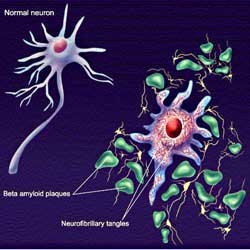Treat Alzheimer's with nano gold particles
Chemists in Chile and Spain have developed a new technique that can stop or slow the progression of Alzheimer's disease - dementia. Especially, this technique does not damage healthy brain cells.

Normal neurons (right) and nerve cells with blue amyloid residues (located outside and around nerve cells).
The team attached nanometer-sized gold particles to a small amount of beta amyloid in the test tube.
The beta amyloid residue is a combination of proteins that are thought to contribute to memory impairment in Alzheimer's patients.
Next, they incubated the mixture for several days and exposed it to a weak microwave field for hours.
The energy level of the microwave field is 6 times smaller than a normal cell phone, so it does not harm healthy cells. As a result, beta amyloid residues are dissolved.
This solubility lasts at least a week. This suggests that the technique not only breaks down beta amyloid residues, but also makes these proteins recombine more slowly.
According to research leader Marcelo J. Kogan of the University of Chile, this technique has the potential to treat neurodegenerative diseases, including Parkinson's and Hungtington's paralysis. It is similar to the technique of using nanoscale metal particles to label and destroy cancer cells.
Currently the research team is preparing to conduct experiments in animals.
Minh Son
- Successfully manufactured the world's thinnest gold leaf
- You will be surprised to know what the gold dust particles in this photo are actually!
- The golden sun is made of chip manufacturing technology
- Turn transparent gold nanoparticles into mirrors that reflect only one current
- Gold is formed like?
- The interesting thing about gold may be unknown to you
- Why do we like gold?
- The smallest engine in the world is a million times smaller than an ant
- Difficult questions: How much gold is in the sea?
- 4,000-year-old dagger knife attaches more than 140,000 gold beads
- Interesting little things about gold
- Instructions on how to buy gold, distinguish real gold and fake gold
 Green tea cleans teeth better than mouthwash?
Green tea cleans teeth better than mouthwash? Death kiss: This is why you should not let anyone kiss your baby's lips
Death kiss: This is why you should not let anyone kiss your baby's lips What is salmonellosis?
What is salmonellosis? Caution should be exercised when using aloe vera through eating and drinking
Caution should be exercised when using aloe vera through eating and drinking